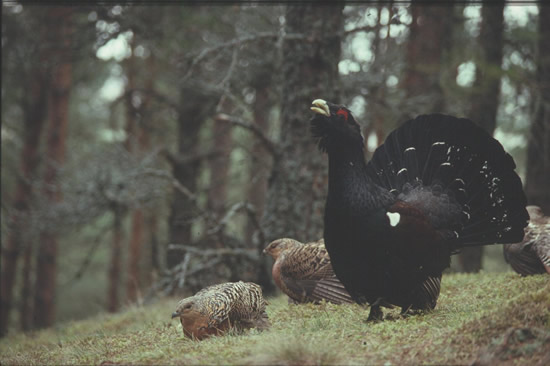
Neil Cook, Glen Muick
It is four o'clock on a fine April morning, still dark in the old forest, song birds quietly asleep. Then through the calm air a resonant click ... a series of clicks ... a pop ... and a sound that has been variously described as like a knife being whetted, or like a small bird singing. It is in fact the rushing of air as the capercaillie cock roars his challenge to other cocks. But we can't hear the full roaring, it is below our limit of hearing. And our grandchildren may not hear the song at all because the bird may be extinct in Scotland in 10 years or so.
Centuries of felling, burning and overgrazing left the 18th century Scottish landscape largely treeless. Capercaillie, souls of the forest, survived in scattered remnant woods. That was also the time of Little Ice Age with cold, wet summers, when the few remaining birds must have found it difficult to rear young. The last record of native Scottish capercaillie was in the 1780s - two cocks shot on the occasion of a marriage rejoicing at Balmoral. In the late 18th and early 19th centuries, new forests were planted. Attempts to reintroduce capercaillie met with success in the 1830s. In the new forests, game preservers killed predators and the bird abounded.

Neil Cook, Glen Muick |
By 1990 the bird was in obvious decline and estates agreed to a voluntary ban on shooting. The Scottish Office, at the behest of Lord James Douglas-Hamilton, initiated a programme of scientific research. The research was done, the reasons for the decline comprehended, and prescriptions for reversing it were made. This will require a concerted effort by all concerned.
The main causes of the decline have been poor breeding associated with climate change and unnecessary deaths from birds flying into forest fences. Contributory factors include habitat loss, habitat degradation due largely to overgrazing by excessive red deer, predation, and indiscriminate misuse of fox snares. We should be able to reverse the decline by reducing adult deaths and by improving breeding success.
The Scottish and European authorities have woken up to the problem. Some £10 million pounds has been committed by various organizations to capercaillie conservation. This includes £4.5 million under an EU LIFE initiative, co-ordinated by Kenny Kortland, the Capercaillie Project Officer.
The poorer breeding seems to be due to a change in the spring weather. The hens need a quick burst of new plant growth in mid April to boost their diet, so that they lay good quality eggs that hatch into viable chicks. Climate change has meant that many months have become warmer, but this does not apply to April. Although early April is now milder than it was in the 1970s, mid April is colder, the pattern of plant growth has changed, and the hens' diet is poorer. We cannot do much about climate change but we can improve the chicks' chances of survival by improving their habitat, crucially blaeberry, and killing their main enemies - crows and foxes.
One step towards reducing adult mortality is to take down forest fences and control deer numbers by shooting. This should increase local jobs for stalkers. Fences are an idle man's way of managing deer. If fences are deemed essential, they should be sited away from trees and marked to increase visibility.
Indiscriminate use of fox snares is another big problem that has mushroomed in the last few years, apparently spearheaded by unbalanced advice from the Game Conservancy. There is of course widespread flouting of the law on many upland estates, where the Wildlife and Countryside Act is regarded with contempt. Killing pine martens and protected birds of prey is commonplace and goes largely unchecked by police. Less well known are the side effects of some modern methods of snaring foxes. These involve setting scores or even hundreds of snares through a forest, with the inevitable consequence that so-called non-target species, such as hares, deer, wildcats, badgers and capercaillie are illegally killed. When did you last see a wildcat? If this practice goes unchecked, the Scottish wildcat may precede the capercaillie to extinction.
Robert Moss, 19 September 2002
Ballater Seminar Report | RSPB News
Please let the webmaster know if there are problems with viewing these pages or with the links they contain.